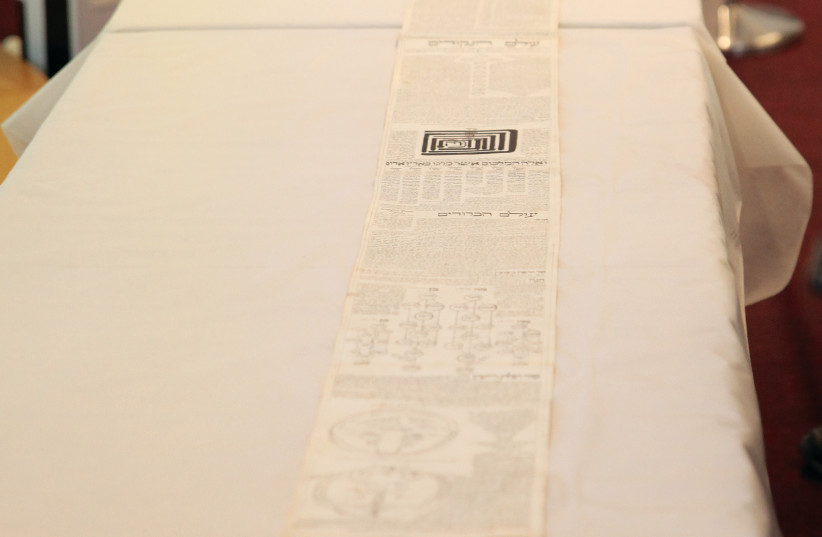Since the dawn of human history, mankind has tried to find a way to be close to God. For some, God is far removed from human existence. But for others, including the Kabbalists beginning in the 13th century, God is much closer.
“Kabbalah is a language in which to speak of God, describe the world, come into contact with it and influence a reciprocal relationship between human consciousness and divine consciousness,” Dr. Melila Hellner-Eshed, who taught mysticism at the Hebrew University for decades, told The Jerusalem Post. “Everything is connected. We are all in one web and connected to divinity.”
One way that Kabbalists express that connection is through “ilanot” or trees, parchment sheets with the kabbalistic “tree of life.” The National Library of Israel has now acquired 36 parchment and paper scrolls for an estimated $1 million. It means that in addition to the 25 scrolls the library already owned, it now has the world’s largest collection of “ilanot.”
“This collection allows us to be on the forefront of research for scholars of Kabbalah and mysticism and signifies the library’s investment and focus on being the library of the Jewish people worldwide,” Raquel Ukeles, head of collections at NLI, told a small group of journalists.
The unveiling of the collection comes as the library is preparing to move to its own new building, which will enable it to interact more with the public and display the scrolls.

A different kind of tree
The “ilanot” have branches that are composed of words and images rooted in the fundamentals of Kabbalah. Some even contain drawings of a face, which is how the Kabbalists imagined the face of the Divine. While the kabbalistic tradition of scrolls dates back to the 14th century, the new collection of “ilanot” are dated between 1660 and 1920. Most are illustrated with words and pictures, and some are even illuminated with colors. The craftsmanship is impressive, even for those of us who know little about Kabbalah.
The Kabbalah talks about 10 sefirot or attributes of God. They are also associated with different biblical characters, different names of God and different aspects of divinity. For example, Abraham is “hessed” or loving-kindness, while Isaac is associated with “din,” or judgment.
At the press preview, Chaim Neria, the curator of the Haim and Hanna Solomon Jewish Collection at the library, unrolled what is believed to be the longest scroll in the world, clocking in at over 11 meters. It was completed in 1872 by Rabbi Sasson ben Mordechai Shandukh, who lived in Baghdad.
At the bottom of the scroll were features that looked very human, including a mustache and a nose.
“This picture in the eyes of the majority of Jews is of something pagan, or like idol worship,” he said. “But this was the world of the Kabbalists.”
He said that the “ilanot” are a new genre of Jewish creativity. The “ilanot” look like upside-down trees and are an attempt to draw a map of the upper worlds, he said. Some of the “ilanot” were even hung in homes,” he said.
Academic study of the “ilanot” is still a relatively young field in Jewish studies. Last year one of the world’s experts on the issue, J.H. Chayes, wrote a serious tome called The Kabbalistic Tree, which has 250 beautifully produced images, including many from the Gross Family Collection which are now part of the NLI.
The book also describes how Jews began to visualize and draw the mystical shape of the Divine. In describing Chayes’s book, Amazon says of “ilanot”: “At once maps, mandalas and memory palaces, ilanot provided Kabbalists with diagrammatic representations of their structured image of God. Scrolling an ilan parchment in contemplative study, the Kabbalist participated mimetically in tikkun, the development and perfection of Divinity.”
The “ilanot” were made all over the world, from Spain (prior to the Jewish expulsion in 1492) to Crete, Kurdistan, Yemen, Italy and all over the Middle East.
The rector of the NLI, Shai Nitzan, was also at the press preview of the new collection.
“The kabbalistic trees are among the one-of-a-kind collections we are acquiring in advance of the National Library of Israel’s move to its new location,” he said. “We are committed to enriching the library with items that will expand our collections, and making them accessible to the public, reinforcing our vision to serve as the curator of the spiritual treasures of the Jewish people.”
He even got emotional as he spoke about the NLI’s new collection.
“This is one of the most amazing things we have here,” he said. “It is emotional for every Jew. You don’t have to be religious to be impressed by this.”
WHEN PROF. Gershom Scholem, who is known as the founder of the academic study of Kabbalah, died, his personal library was donated to the National Library. The library’s Gershom Scholem Collection has over 35,000 books, including 3,000 rare books and hundreds of manuscripts.
Nitzan said the NLI has more than four million books and 1,500 archives, as well as an impressive collection of Middle Eastern maps. The library has launched a process of digitization of its collection, which will enable scholars and laymen to access it more easily.
He said the library is the oldest Zionist institution, as it was formed even before the First Zionist Congress, and it therefore played a role in state building in the early days of Israel.
“We are delighted that these rare items will be an integral part of our national memory, preserved on the one hand but also digitally and physically accessible on the other,” Ukeles said. “They will receive the recognition they deserve as distinctly Jewish works and as rare treasures of the National Library of Israel.”
As the National Library prepares for its new permanent home, the collection of “ilanot” will form the cornerstone of one of the most important collections of Judaica.
